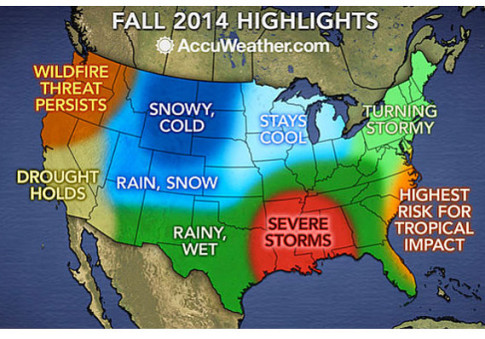– Brace for a September ‘polar vortex’ (Market Watch, Aug 7, 2104):
It’s already August, which means fall is around the corner – and another winter no longer seems that far away. Forecasters are out with some predictions about the weather we can expect in the coming months:
– A polar vortex (if we’re allowed to call it that when it’s not winter) across the Great Lakes and into the interior Northeast during mid-to-late September, says Paul Pastelok, Accuweather’s lead long-range forecaster.
“Temperatures [in the Northeast] will not be as extreme in November when compared to last year, but October could be an extreme month,” he said on Accuweather’s website.
Then plan on a wet November and early winter snow in the northeast, including a couple of big storms in December and early January.
– Early snow and cold in the northern Plains and northern Rockies this fall, according to Accuweather. The cold could expand as far east as the Chicago area.
The National Weather Service, however, is calling for above-average temperatures across the northern Rockies, Plains and Midwest states, including Chicago, over the November-to-January period.
– Above-normal rain from from New Orleans to Atlanta this fall, Accuweather says.
– El Nino will bring moisture to the southwest and Texas in the fall. But no drought relief for California, according to Accuweather. The National Weather Service says expect below-average temperatures in southern Texas in the November-to-January period.
– While Hawaii braces for two hurricanes, the National Oceanic and Atmospheric Administration on Thursday raised the odds of a below-normal hurricane season in the Atlantic and Gulf of Mexico to 70%, from the 50% odds given in May. It says there could be between zero and two major hurricanes, which are category 3 or higher. Hurricane season runs through Nov. 30.
Looking backward, June was the wettest June nationally since 1989, even as 34% of the lower 48 suffered drought conditions, the NOAA said. Worldwide, average land and ocean temperatures in June were the highest since records began in 1880.
